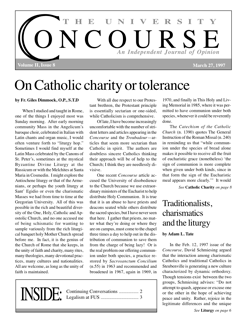Traditionalists, charismatics and the liturgy
by Adam Tate
In the Feb. 12, 1997 issue of the Concourse, David Schmiesing argued that the interaction among charismatic Catholics and traditional Catholics in Steubenville is generating a new culture characterized by dynamic orthodoxy. Though tensions exist between the two groups, Schmiesing advises: “Do not attempt to quash, appease or excuse one or the other in the hope of achieving peace and unity. Rather, rejoice in the legitimate differences and the unique phenomenon that is taking place on a hilltop in the Ohio Valley.”
Schmiesing’s article is provocative but incomplete. While a new culture might exist at Steubenville, there is room to critique it and call for the development of a still fuller and more vibrant orthodox Catholicism at the University.
The charismatic/traditionalist debate continues because the terms of the debate are unclear. Charismatics and traditionalists attack each other in vague ways and refuse to grapple with the theological and pastoral issues involved in their spiritualities. Often critics will not only denounce spiritual excesses (as they should) but caricature the opposing spirituality by suggesting that the excesses represent its totality. Such attacks are unfair. Also, as with all debates, human pride, personal reputations and strong emotions obscure an honest assessment of the spiritual situation at Steubenville. Thus the debate flounders.
The Church’s teaching on spirituality must be established before serious discussion can begin. A spirituality is a way of approaching and worshipping God. The Catechism notes that the “different schools of Christian spirituality share in the living tradition of prayer and are essential guides for the faithful”(CCC 2684). Thus authentic Catholic spiritualities reveal the richness and diversity of the Catholic and human experience. A person selects a certain spirituality because it particularly touches his soul and speaks to his personality. There are many spiritualities because there are many human needs and many personalities. In its spiritual diversity the Church can say that she is, as Henri de Lubac has written, truly the home of all men. At the same time, all spiritualities, because they are practiced by sinful humans, have their excesses. The excesses are important to recognize and guard against, but they do not, by themselves, invalidate the spirituality as such.
The characteristic excesses of the charismatic and traditionalist spiritualities are well known. The charismatic experience can become emotivistic and subjectivistic—its adherents sometimes treating the intensity of their religious experiences as a therapeutic solution to personal problems. They might move from prayer meeting to prayer meeting in search of an emotional high, thus denigrating religion to a form of spiritual Prozac. Charismatics can also slip into antinomianism—thinking that since God speaks to them directly every day they do not need a magisterium to guide them. Traditionalism can tend toward scrupulosity, legalistic rigorism and extreme spiritual individualism. Traditionalists too can slip into heresy and schism, as is evident in such groups as the Society of St. Pius X. But to discredit either charismatic or traditionalist spirituality as a whole, on the basis of their respective abuses, is unjust and foolish. It is the proverbial throwing the baby out with the bath water.
Though charismatics and traditionalists both practice authentic spiritualities, their primary differences concern the liturgy. While spiritualities might aid one in private devotion or in a prayer group, not all spiritualities belong at Mass. The liturgy is “the participation of the People of God in ‘the work of God’”(CCC 1069). It is a communal and priestly action. Therefore, the realm of spirituality, which is essentially a personal and private matter, must be submitted to the judgment of the Church before finding a permanent place in liturgical worship. In my estimation, the charismatic spirituality has little or no place in the Mass as it presently stands and thus should be practiced outside of the common liturgical action of the People of God.1
While Steubenville prides itself on its dynamic orthodoxy, in my opinion, the liturgical renewal called for by Vatican II has not been fully realized on campus, because of the overemphasis on the charismatic renewal. After reading Sacrosanctam Concilium and some of the post-conciliar liturgical documents in a theology class, I became puzzled at their lack of implementation at campus liturgies. In addition, a central principle of Sacrosanctam Concilium, that an individual priest may not “add, remove, or change anything in the liturgy on his own authority,” seemed to be neglected by charismatics (SC 22). For example, the inclusion of an extra song of praise after the Gloria, speaking in tongues during the minor elevation, and giving “prophecies” after communion remained outside the rubrics of the Mass, yet were practiced on a weekly basis on campus. While most Steubenville charismatics would condemn the liturgical tampering of liberal priests, the same charismatics sanction their own tampering with the liturgy in order to promote the charismatic renewal. Such posturing is puzzling and inconsistent.
Despite the charismatic additions to the Mass, there were other ways Steubenville could have grown closer to the liturgical teachings of Vatican II. First, while many young people loved the charismatic hymns at Steubenville, most of these songs seem not to fit the category of sacred, liturgical music. Though Sacrosanctam Concilium asked that “highest esteem” be given to the organ in sacred music, the guitar was the dominant instrument in Steubenville liturgies (SC 120). Gregorian chant, another traditional treasure of the Church endorsed by Sacrosanctam Concilium, was also a rarity at Mass (SC 116). Second, the proliferation of extraordinary ministers of the Eucharist and the insistence at every Mass upon communion under both kinds seemed to ignore the directives of the Council. There are actually few instances in which the Council thought it wise for the laity to receive the precious blood (although the instances of reception of the precious blood were left up to the local bishop to decide). The daily offering of communion under both kinds encouraged what seemed to me an excessive use of extraordinary ministers of the Eucharist. Third, the Council insisted that “care must be taken to ensure that the faithful may also be able to say or sing together in Latin those parts of the Ordinary of the Mass which pertain to them”(SC 54). While the Sanctus and the Agnus Dei were often chanted, the Gloria or the Credo were never chanted or spoken in Latin. Finally, liturgical dancing, a practice forbidden in North America by the Church, took place, though before the entrance procession. This I consider a case of following the letter of the law while ignoring its spirit. In sum, there is significant room for liturgical renewal at Steubenville to make the campus even more dynamically orthodox.
While some might complain that my suggestions and criticisms are unduly harsh or typically traditionalist, I point out that I have based my opinions on the documents of Vatican II. I have refrained purposely from arguing for the celebration of the traditional Latin Mass, in order to focus the discussion on the gap between Sacrosanctam Concilium and the campus liturgies, instead of on my own traditionalist preferences. As I see it, the central problem of the charismatic/traditionalist debate at Franciscan University is not the existence of either spirituality in the household system and campus organizations, but the prevalence of charismatic practices in the liturgy and the failure to incorporate sufficiently the reforms of Sacrosanctam Concilium.
Dynamic orthodoxy needs to spill over to the liturgy at Steubenville. A true liturgical renewal will serve to invigorate the new culture David Schmiesing identified in his article.
Adam Tate, Class ‘94, is working on his PhD in history at the University of Alabama. His wife, Eugenie (Lightfoot ‘95) teaches high school theology and is a youth minister for the local parish. They live in Tuscaloosa, Alabama.
- My position might be better understood if I explain that I entered Steubenville in the Fall of 1990 as a fervent charismatic. In the Fall of 1991 I went to Gaming, as part of the first Austrian class. There I discovered the richness of the Catholic tradition, and began to move away from my charismatic spirituality. Today I consider myself an orthodox traditionalist. In discussing the liturgy at Steubenville I must say that I have not returned to campus since my graduation in May of 1994. Therefore, some of my comments may be anachronistic. ↑


